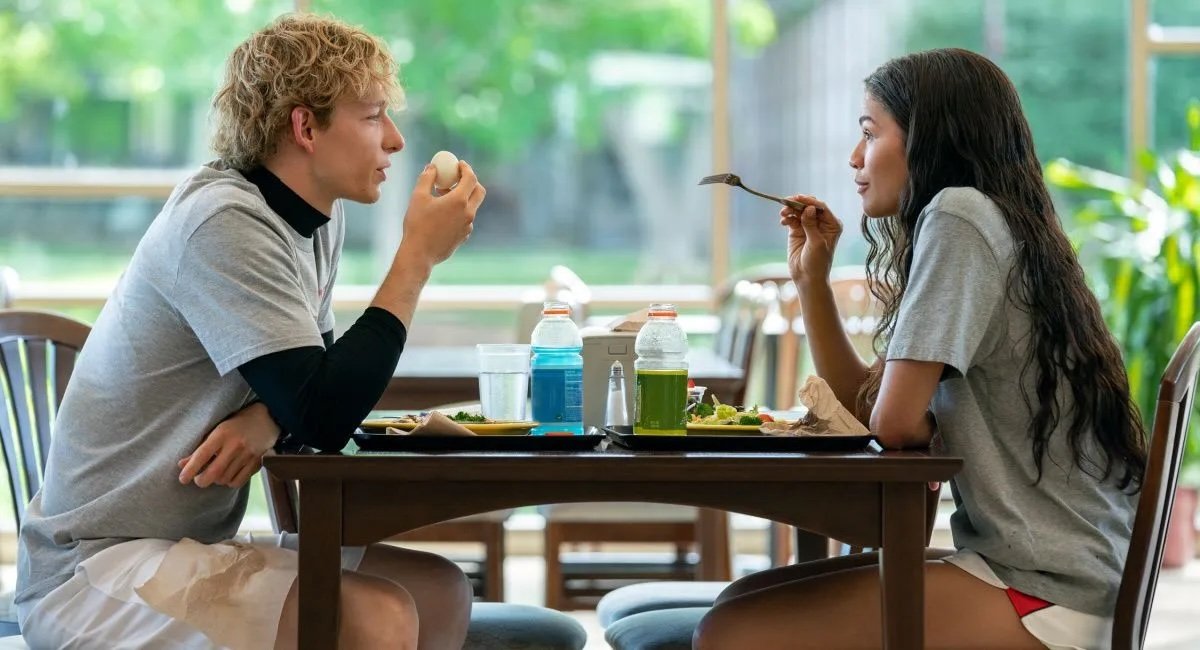With Challengers, Guadagnino and Company Dive into Beauty and Ruin
First things first: Yes, Challengers is a sexy movie, stupendously sexy even. It achieves this sexiness through the thorned chemistry leads Zendaya, Mike Faist and Josh O’Connor build as peers, rivals, lovers and enemies; the attention DP Sayonbhu Mukdeeprom pays to the way bodies move in competition, when seeking pleasure, and at rest; a driving, catchy score from Trent Reznor and Atticus Ross; and writer Justin Kuritzkes and director Luca Guadagnino’s embrace of both the intimate and the absurd.
Challengers, from its much ballyhooed three-way-makeout-turned-lifelong-friends-acting-on-their-sublimated-attraction scene to Faist and O’Connor’s sauna-set verbal duel about the lives they live, reliably captures the spikes and sparks of attraction—the ways that desire, care, anger, and the human need to taunt blend together. That blend’s never the same—it’s human interaction, not a post-workout protein shake—but Challengers’ core triangular relationship and the trio’s separate relationships do exist on a continuum with each other.
Zendaya’s would-have-been-an-all-time-great-but-for-a-ruinous-leg-injury tennis player Tashi Duncan is steady veering on stagnant in her friendship and eventual marriage with Faist’s very-good-by-virtue-of-work-and-inertia pro Art Donaldson. Tashi’s scenes with O’Connor’s all-but-burnt-out-tennis-ronin-and-deliberate-jackass Patrick Zweig are stormier (in one case literally)—higher highs and lower lows. Art and Patrick grew up loving each other, but between their mutual desire for Tashi and their wildly different approaches to tennis and life that love curdled into loathe—even though their shared language and intimacy remain. For all the ways that the trio’s lives are ritzy and glamorous (or in Patrick’s case, were once ritzy and glamorous and could perhaps be again), the game’s never easy. They wouldn’t have it any other way. They couldn’t.
So yes, Challengers is spectacularly sexy, and that’s a big part of why it succeeds—but not the only part. From the opening shot of a be-briefed Art fighting the inevitability of waking up post alarm on, Guadagnino and company are just as interested in the physical toll of an athlete’s life and how that toll bleeds (sometimes literally) into everything else. Tennis is not, say , mixed martial arts or ballet, but it’s vicious all the same.
Art, a top-of-the-game pro whose staff includes a world class physical therapist and whose toolkit includes custom electrolyte mixes, is in awe-inspiring shape. He is also covered in scars. And his toes? Aggghhhh. Tashi’s well over a decade out from her leg breaking, and when it happened, she received immediate, high quality medical treatment. She physically cannot play on the level she could pre-break. Patrick, the wandering tennis ronin, has not visibly taken damage on the same level as the other two sides of the triangle, but he’s in his 30s. If he sleeps in his car (which he does), it will affect his game.
Tashi pushes Art to take the US Open (and thus complete a career grand slam) at least in part because she knows how good she was, and how far she could have gone but for the break. Art’s malaise and depression are fed, in part, by his being physically worn out. Patrick’s desperation to claw his way out of the challengers and into major competition comes as much from his knowing that he will hit a physical wall and soon as it does his need to win some sort of glory.
Guadagnino and company interlink the physical and the emotional, explicitly (Patrick has an incredibly distinct serve. When he changes it, it’s a deliberate message to Art.) and implicitly (Art downs an energy gel quickly and methodically. His life is a process, a ritual, step by step and serve by serve. Patrick relishes a banana since it offers a chance to screw with Art while also offering quick and easy carbs.). It clicks. Challengers turns on a trio who’ve made tennis their lives—of course their physicality would tie into how they move through their days. Moreover, the game’s physical toll means that, whether they acknowledge it or not, Patrick and Art only have so long to be able to settle things on the court. Much as they might deny it, subconsciously they know that their 2019 match is a very, very big deal for them. It’s a big deal for the Phil’s Tire Town tournament, sure, but Phil’s Tire Town will run again in 2021. Patrick and Art might not be playing at that point.
For Challengers, the physical—whether astonishing or calamitous or some combination thereof—is, by virtue of the rules of tennis and Tashi, Art, and Patrick’s history, the intimate. To play someone is to know them, and for the trio, to know each other is to play each other. Slights and kindnesses, manipulation and honesty, defeat and victory—everything’s wrapped up in everything else, and expressed through serves and returns, outs and fouls, shattered tennis racquets and point deductions for verbal obscenities.
It's heady, steamy, often hysterical, and it commands attention. Its linking of the physical and the emotional is tremendously compelling. Or, to put it more plainly, Challengers is a hell of a film—well-performed, well-scored, well-choreographed and well worth seeing.




Justin Harrison is an essayist and critic based in Austin, Texas. He moved there for school and aims to stay for as long as he can afford it. Depending on the day you ask him, his favorite film is either Army of Shadows, Bring Me the Head of Alfredo Garcia, The Brothers Bloom, Green Room, or something else entirely. He’s a sucker for crime stories. His work, which includes film criticism, comics criticism, and some recent work on video games, can be found HERE.